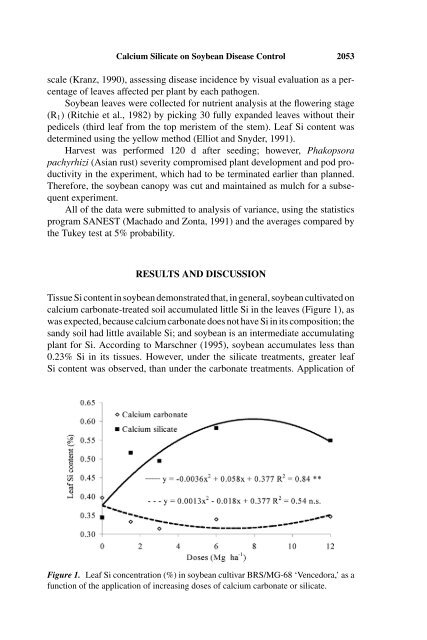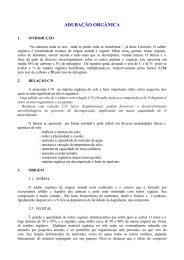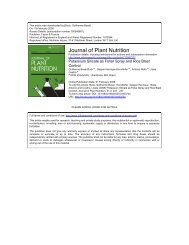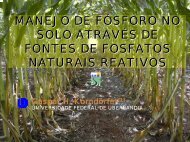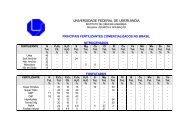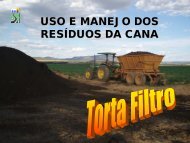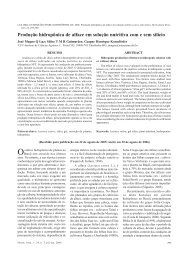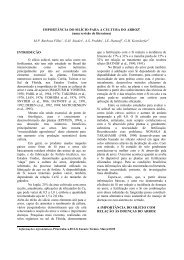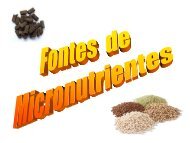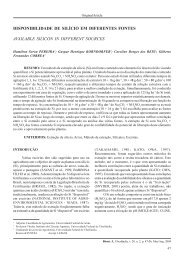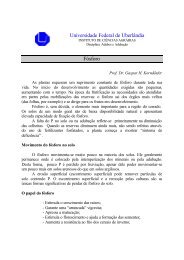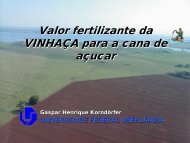2052 A. Nolla et al.selected due to its low concentration <strong>of</strong> available Si (s<strong>and</strong>y texture) (Beckwith<strong>and</strong> Reeve, 1963) <strong>and</strong>, consequently, greater probability <strong>of</strong> plant response tosoil application <strong>of</strong> that element.Due to the naturally low fertility <strong>of</strong> the soil collected, soil fertilization wasperformed by add<strong>in</strong>g, with the aid <strong>of</strong> a concrete mixer, the equivalent <strong>of</strong> 400 kgP 2 O 5 ha −1 , 400 kg K 2 Oha −1 , 240 kg magnesium (Mg) ha −1 , <strong>and</strong> 100 kg <strong>of</strong> amicronutrient fertilizer <strong>in</strong> the form <strong>of</strong> frited trace element (FTE) [9% z<strong>in</strong>c (Zn),1.8% boron (B), 2% manganese (Mn), 0.8% copper (Cu), 0.1% molybdenum(Mo), <strong>and</strong> 3% iron (Fe)]. Subsequently, 200 kg lots <strong>of</strong> the soil were placed <strong>in</strong>250 L drums 54 cm <strong>in</strong> diameter × 83 cm <strong>in</strong> height. The drums were placed<strong>in</strong> an open <strong>and</strong> fenced area over crushed rocks to avoid contam<strong>in</strong>ation <strong>of</strong> thesoil <strong>in</strong> the columns. Excess water <strong>in</strong> the columns was avoided by punch<strong>in</strong>g five1.3 cm diameter holes <strong>in</strong>to the upper <strong>and</strong> lower ends <strong>of</strong> the side <strong>of</strong> the drum.The equivalent <strong>of</strong> 0, 1500, 3000 (lim<strong>in</strong>g requirement), 6000, <strong>and</strong>12,000 kg ha −1 calcium carbonate (99% CaCO 3 )orcalcium silicate, providedby the company Rockfibras do Brasil (18% CaO <strong>and</strong> 40% SiO 2 ), was appliedto the column surface (without <strong>in</strong>corporation), <strong>in</strong> a r<strong>and</strong>omized block designwith four repetitions, as a 2 × 5factorial experiment (two materials <strong>and</strong> fivedoses). The soil columns were left fallow for 15 d, then irrigated with 12 L <strong>of</strong>water immediately after the application <strong>of</strong> the corrective materials to allow fora better reactivity with the soil.The soybean cultivar used was BRS/MG-68 ‘Vencedora,’ which has a determ<strong>in</strong>ategrowth habit; average plant height <strong>of</strong> 80 cm; average <strong>in</strong>sertion height <strong>of</strong>the first pod <strong>of</strong> 15 cm; purple-colored flowers; brown pubescence; black hilum;good resistance to stalk<strong>in</strong>g; good seed quality <strong>and</strong> resistance to frog’s eye spot(Cercospora soj<strong>in</strong>a), bacterial pustule (Xanthomonas campestris pv glyc<strong>in</strong>ea),bacterial blight (Pseudomonas syr<strong>in</strong>gae pv glyc<strong>in</strong>ea), powdery mildew (Microsphaeradiffusa), <strong>and</strong> stem canker (Phomopsis phaseoli f.sp. meridionalis).This cultivar is also tolerant to the gall nematodes (Meloydog<strong>in</strong>e <strong>in</strong>cognita<strong>and</strong> M. javanica); however, it is susceptible to the cyst nematode (Heteroderaglyc<strong>in</strong>es) (EMBRAPA, 2004).Twenty Bradyrhizobium japonicum pre-<strong>in</strong>oculated seeds were planted onDecember 23, 2003 <strong>in</strong> the drums, <strong>in</strong> two rows spaced at 0.25 cm, <strong>and</strong> wereth<strong>in</strong>ned to five plants per row. <strong>Soybean</strong> seeds were not fungicide treated, so diseasedevelopment could be monitored dur<strong>in</strong>g the culture cycle. The experimentsimulated direct plant<strong>in</strong>g <strong>and</strong> culture rotation with sugar cane (Saccharum <strong>of</strong>fic<strong>in</strong>arum);therefore, the equivalent <strong>of</strong> 10 mg ha −1 sugar cane straw mulch wasapplied to the surface <strong>of</strong> the drums. The soil moisture was ma<strong>in</strong>ta<strong>in</strong>ed throughra<strong>in</strong>fall or by irrigation (with tap water) dur<strong>in</strong>g the dry season.Only an <strong>in</strong>secticide was used for pest (Nezara viridula) control dur<strong>in</strong>gthe culture cycle. Evaluation for disease (Peronospora manshurica—Downymildew, Cercospora soj<strong>in</strong>a—frog’s eye spot, <strong>and</strong> Phakopsora pachyrhizi—Asian rust) was performed at 47, 66, <strong>and</strong> 79 d after plant seed<strong>in</strong>g. Three plantswere selected per drum, <strong>and</strong> disease was evaluated us<strong>in</strong>g the Horsfall <strong>and</strong> Barrat
<strong>Calcium</strong> <strong>Silicate</strong> on <strong>Soybean</strong> <strong>Disease</strong> Control 2053scale (Kranz, 1990), assess<strong>in</strong>g disease <strong>in</strong>cidence by visual evaluation as a percentage<strong>of</strong> leaves affected per plant by each pathogen.<strong>Soybean</strong> leaves were collected for nutrient analysis at the flower<strong>in</strong>g stage(R 1 ) (Ritchie et al., 1982) by pick<strong>in</strong>g 30 fully exp<strong>and</strong>ed leaves without theirpedicels (third leaf from the top meristem <strong>of</strong> the stem). Leaf Si content wasdeterm<strong>in</strong>ed us<strong>in</strong>g the yellow method (Elliot <strong>and</strong> Snyder, 1991).Harvest was performed 120 d after seed<strong>in</strong>g; however, Phakopsorapachyrhizi (Asian rust) severity compromised plant development <strong>and</strong> pod productivity<strong>in</strong> the experiment, which had to be term<strong>in</strong>ated earlier than planned.Therefore, the soybean canopy was cut <strong>and</strong> ma<strong>in</strong>ta<strong>in</strong>ed as mulch for a subsequentexperiment.All <strong>of</strong> the data were submitted to analysis <strong>of</strong> variance, us<strong>in</strong>g the statisticsprogram SANEST (Machado <strong>and</strong> Zonta, 1991) <strong>and</strong> the averages compared bythe Tukey test at 5% probability.RESULTS AND DISCUSSIONTissue Si content <strong>in</strong> soybean demonstrated that, <strong>in</strong> general, soybean cultivated oncalcium carbonate-treated soil accumulated little Si <strong>in</strong> the leaves (Figure 1), aswasexpected, because calcium carbonate does not have Si <strong>in</strong> its composition; thes<strong>and</strong>y soil had little available Si; <strong>and</strong> soybean is an <strong>in</strong>termediate accumulat<strong>in</strong>gplant for Si. Accord<strong>in</strong>g to Marschner (1995), soybean accumulates less than0.23% Si <strong>in</strong> its tissues. However, under the silicate treatments, greater leafSi content was observed, than under the carbonate treatments. Application <strong>of</strong>Figure 1. Leaf Si concentration (%) <strong>in</strong> soybean cultivar BRS/MG-68 ‘Vencedora,’ as afunction <strong>of</strong> the application <strong>of</strong> <strong>in</strong>creas<strong>in</strong>g doses <strong>of</strong> calcium carbonate or silicate.


